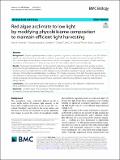Files in this item
Red algae acclimate to low light by modifying phycobilisome composition to maintain efficient light harvesting
Item metadata
| dc.contributor.author | Voerman, Sofie E. | |
| dc.contributor.author | Ruseckas, Arvydas | |
| dc.contributor.author | Turnbull, Graham A. | |
| dc.contributor.author | Samuel, Ifor D. W. | |
| dc.contributor.author | Burdett, Heidi L. | |
| dc.date.accessioned | 2023-01-06T10:30:15Z | |
| dc.date.available | 2023-01-06T10:30:15Z | |
| dc.date.issued | 2022-12-27 | |
| dc.identifier | 282828046 | |
| dc.identifier | cda11d17-c5cb-47d4-85a3-57eb033231c3 | |
| dc.identifier | 85144811279 | |
| dc.identifier | 000905168100007 | |
| dc.identifier.citation | Voerman , S E , Ruseckas , A , Turnbull , G A , Samuel , I D W & Burdett , H L 2022 , ' Red algae acclimate to low light by modifying phycobilisome composition to maintain efficient light harvesting ' , BMC Biology , vol. 20 , 291 . https://doi.org/10.1186/s12915-022-01480-3 | en |
| dc.identifier.issn | 1741-7007 | |
| dc.identifier.other | RIS: urn:85EE166F7375179345B3120C41E494BE | |
| dc.identifier.other | RIS: Voerman2022 | |
| dc.identifier.other | ORCID: /0000-0001-9114-3522/work/126031807 | |
| dc.identifier.uri | https://hdl.handle.net/10023/26696 | |
| dc.description | Funding: Funding was provided by a Engineering and Physical Sciences Research Council EP/L017008/1 to GT & IS and a Leverhulme Trust Research Project Grant (RPG-2018–113) to HB, GT and IS. | en |
| dc.description.abstract | Background Despite a global prevalence of photosynthetic organisms in the ocean’s mesophotic zone (30–200+ m depth), the mechanisms that enable photosynthesis to proceed in this low light environment are poorly defined. Red coralline algae are the deepest known marine benthic macroalgae — here we investigated the light harvesting mechanism and mesophotic acclimatory response of the red coralline alga Lithothamnion glaciale. Results Following initial absorption by phycourobilin and phycoerythrobilin in phycoerythrin, energy was transferred from the phycobilisome to photosystems I and II within 120 ps. This enabled delivery of 94% of excitations to reaction centres. Low light intensity, and to a lesser extent a mesophotic spectrum, caused significant acclimatory change in chromophores and biliproteins, including a 10% increase in phycoerythrin light harvesting capacity and a 20% reduction in chlorophyll-a concentration and photon requirements for photosystems I and II. The rate of energy transfer remained consistent across experimental treatments, indicating an acclimatory response that maintains energy transfer. Conclusions Our results demonstrate that responsive light harvesting by phycobilisomes and photosystem functional acclimation are key to red algal success in the mesophotic zone. | |
| dc.format.extent | 16 | |
| dc.format.extent | 3897898 | |
| dc.language.iso | eng | |
| dc.relation.ispartof | BMC Biology | en |
| dc.subject | Coralline algae | en |
| dc.subject | Photosynthesis | en |
| dc.subject | Phycobilisome | en |
| dc.subject | Mesophotic | en |
| dc.subject | Fluorescence | en |
| dc.subject | Photosystem | en |
| dc.subject | Photo-acclimation | en |
| dc.subject | Chromo-acclimation | en |
| dc.subject | Maerl | en |
| dc.subject | Rhodolith | en |
| dc.subject | DAS | en |
| dc.subject | SDG 14 - Life Below Water | en |
| dc.title | Red algae acclimate to low light by modifying phycobilisome composition to maintain efficient light harvesting | en |
| dc.type | Journal article | en |
| dc.contributor.sponsor | EPSRC | en |
| dc.contributor.sponsor | The Leverhulme Trust | en |
| dc.contributor.institution | University of St Andrews. School of Physics and Astronomy | en |
| dc.contributor.institution | University of St Andrews. Centre for Energy Ethics | en |
| dc.contributor.institution | University of St Andrews. Sir James Mackenzie Institute for Early Diagnosis | en |
| dc.contributor.institution | University of St Andrews. Centre for Biophotonics | en |
| dc.contributor.institution | University of St Andrews. Condensed Matter Physics | en |
| dc.identifier.doi | 10.1186/s12915-022-01480-3 | |
| dc.description.status | Peer reviewed | en |
| dc.identifier.grantnumber | ep/l017008/1 | en |
| dc.identifier.grantnumber | RPG-2018-113 | en |
This item appears in the following Collection(s)
Items in the St Andrews Research Repository are protected by copyright, with all rights reserved, unless otherwise indicated.

